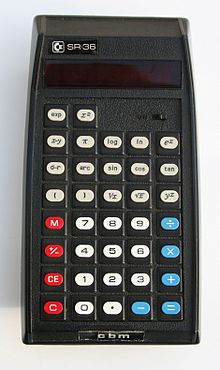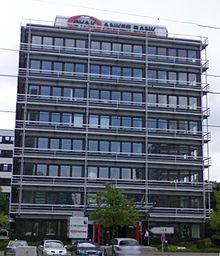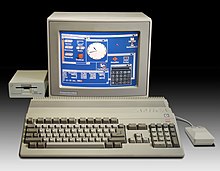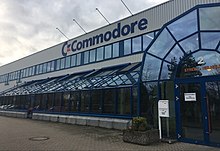Commodore International
| Commodore International
|
|
|---|---|
| legal form | Corporation |
| founding | 1954 |
| resolution | April 29, 1994 |
| Seat | West Chester, Pennsylvania , United States |
| management |
Jack Tramiel (Founder) Irving Gould (Chairman) |
| Branch | Microelectronics , personal computers |
Commodore International was a West Chester, Pennsylvania -based company that dominated the home computer market in the 1980s and early 1990s . It was also the market leader in the early 1980s for the first commercial applications of microcomputers in education, research, manufacturing and the office.
The company went on 29 April 1994 officially in bankruptcy . The brand name Commodore still exists today: Tulip sold, among other things, telephones under the name Commodore. The current rights holder and license administrator of the Commodore brand is Polabe Holding NV . In autumn 2016, the German company individual Computers acquired a license for the brand name Commodore from Polabe Holding NV in order to be able to offer hardware products under the name Commodore.
history
The company was founded in 1954 by Jack Tramiel in Toronto and initially manufactured typewriters . The legend that Tramiel was looking for a sonorous term from the marine world and that he noticed a car of the Opel Commodore type in Berlin , whose name he then took over, cannot be true, as this car did not come onto the market until 1967; the detail with the marine term could still apply. Nevertheless, Jack Tramiel himself claims in interviews that he read the name on a car in Berlin. At that time there were many Americans in Berlin, who certainly brought numerous American vehicles with them. For this reason it could have been the Hudson Commodore , which was built in Detroit from 1941.
When a wave of cheap Japanese typewriters hit the market in the late 1950s, Tramiel and his company switched to mechanical adding machines in order not to go under.
In 1962, the company changed the name Commodore Business Machines (CBM) in a corporation to. A few years later, history threatened to repeat itself from the 1950s when Japanese companies began making adding machines themselves. The company's main investor, Irving Gould , suggested Tramiel travel to Japan to test the competitiveness of Japanese companies. He came back with a new idea, the manufacture of pocket calculators . In addition to these, there were also experiments with LED digital wristwatches, chess computers ( Chessmate ) and video games in the successor to Pong, but without much response.
Commodore relied on Texas Instruments to manufacture the calculators , who supplied the components. However, in 1975 they decided to enter the pocket calculator market directly and, due to the in-house production of the components, were able to sell the end product more cheaply than Commodore could buy the components.
The PETs
To get to a cheaper supplier for components, Commodore bought the chip manufacturer MOS Technologies . This brought one of MOS's most important engineers, Chuck Peddle , to Commodore, where he became head of development. Peddle managed to convince Tramiel to move into the microcomputer market and developed the Commodore PET 2001 (Personal Electronic Transactor) - Commodore's first computer, which came on the market in 1977. It was the first computer that was offered in Germany by a large mail order company. The successor models from the CBM 3008 to the CBM 8296 were the first market leaders in the professional sector in Germany and dominated the school, university, production control and office sectors here in the early 1980s.
internationalization
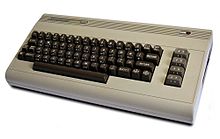
The expansion was consolidated through the establishment of various subsidiaries around the world. In Germany this became the Commodore Büromaschinen GmbH as a 100% subsidiary, initially based in Neu-Isenburg near Frankfurt am Main, and from March 15, 1982 directly in Frankfurt. In Braunschweig a plant (only final production) with its own development department and a distribution warehouse was built. The development department in Braunschweig mainly acquired competence in the field of IBM PC-compatible computers ( Commodore PC-10 to PC-70 and Amiga-Sidecar ), but also worked on the Amiga 2000 (A-Board version) and Amiga 3000 (whose special chips) actively participate.
In Austria there was a branch in Vienna and in Switzerland one in Aesch near Basel . The German and British branches (in London) were the most important sales drivers in the Commodore world; towards the end of Commodore, sales were distributed in such a way that Germany , USA and UK each contributed approx. 30% and the other markets the rest.
The home computers VC20 and C64
The PET was able to prevail mainly in US schools, in the home computer market it failed due to its inferiority to the competition in the areas of graphics and sound. In order to remedy this deficiency, the Volks-Computer 20 (VC 20) was developed, which with its low price could also gain market share in the home computer market. The original name of the computer was "VIC" (after the graphics chip used); However, since the German pronunciation seemed too ambiguous, the name was changed. Commodore Germany subsequently invented the name “Volks-Computer” for the VC20.
In order to open up the upper market segment, the Commodore 64 (C64) was presented in 1982 , which, although initially expensive, impressed with its graphics and music capabilities. A big price war broke out for the home computer market, in which, besides Commodore, the companies Texas Instruments , Atari , and a number of Japanese manufacturers with their MSX systems were involved - practically all manufacturers of the home computer and PC market with the exception of Apple and IBM . Over the years, Commodore was able to sell over 22 million units of the C64 and thus managed to dominate the home computer market, at least in Germany, and to partially push the competitors out of the market. In 1989 the share of computers sold in Germany was around 50%, according to press reports. At times there were special campaigns in Germany in the 1980s where the C16 / C116 / plus4 were sold in the Aldi discounter at relatively low prices, and later the top model C64 followed this path.
This price war did not leave Commodore unaffected either - the financial reserves threatened to be exhausted, and the supervisory board wanted to get out of the overly competitive market segment. As a consequence, a power struggle broke out within the company, which only ended when Jack Tramiel left the company he had founded in 1984 and then bought up former competitor Atari .
Commodore PCs
In the course of the desired consolidation as a provider of personal computers for applications in industry, trade and education, Commodore also saw that the standard defined by IBM for PCs would prevail. A family of compatible computers was therefore developed on its own: first the Commodore PC 10 , followed by other models in this series.
In the early days of the mid-1980s, the Commodore PCs were able to keep up with the competition - for months they alternated with IBM in the leading position of PC sales in Germany. This was mainly due to the high quality of the in-house development. Commodore PCs had the reputation of being “more compatible than IBM” with subsequent models, and they were also considered to be particularly robust.
In the years that followed, however, the effort involved in developing these developments increased to such an extent that developments were initially commissioned externally and finally (in the early 1990s) entire computers from Southeast Asia were purchased. As a result, yields also fell.
The market situation for professional microcomputers (without home computers like VC20) at the end of 1983:
| providers | Units delivered | Delivery shares in percent |
|---|---|---|
| Commodore | 14,500 | 17.0 |
| Apple | 12,000 | 14.0 |
| IBM | 9,700 | 11.5 |
| Hewlett Packard | 7,100 | 8.5 |
Market positions of the six most important providers of professional microphones at the end of 1983:
| rank | providers | Sales market share in percent |
|---|---|---|
| 1 | Commodore | 25.0 |
| 2 | Apple | 16.5 |
| 3 | Hewlett Packard | 11.0 |
| 4th | Tandy | 8.5 |
| 5 | Triumph eagle | 5.0 |
| 6th | IBM | 4.5 |
The Amiga
Commodore urgently needed a new product. The C64 successor projects like the Plus / 4 or the C128 did not turn out to be as successful as desired, some other projects and studies like the C65 never officially saw the light of day. Even computers under the C64, such as the C16 or the C116 , only sold very poorly, as the trend led to more powerful computers instead of smaller and cheaper ones. Commodore therefore bought a new development from a number of former Atari employees - the Amiga computer - and launched it in the spring of 1986 at a price of around 1,500 US dollars. It was the Amiga 1000 , which was intended more as an office computer.
Tramiel's Atari Corporation was faster, however, and was able to bring the roughly comparable Atari ST onto the market as early as 1985 for around 800 US dollars. Again a bitter struggle broke out between Atari and Commodore for dominance in the market, which was finally decided in 1987 by the publication of the Amiga 500 by Commodore.
The corporate market was now shared by Apple and IBM. Despite its technical superiority, Commodore suddenly found himself isolated. Although professional computers were always available in the range, they were difficult to market to the target group of "business users": Commodore developed the "large" series of the original Amiga 1000 over the A2000 , which was successful in film studios due to its expandability The advanced A3000 , whose graphics capability was only slightly expanded, up to the A4000 , which however appeared very late, without being widely used in offices. Too much was attached to the product as a "gaming computer".
The marketing of Commodore at this time is generally considered bad, and Commodore plunged into adventures again and again, apparently without a concept, such as its own IBM-compatible series (which was initially very successful, but later allegedly used up the Amiga's profits) or the publication of Techniques for which there would be no need for years to come, e.g. B. the CD-ROM-based home entertainment system CDTV based on the Amiga 500 (or the later 32-bit successor CD³² based on the Amiga 1200) and loosely based on Philips' CD-i , while simultaneously using the two major existing lines, the C64 and the Amiga, did not develop consistently enough to keep up with the rapidly increasing development speed of the IBM-compatible PCs from the 1990s onwards.
As the end began to appear, plans were developed to concentrate completely on the more successful European market due to the better organization of the subsidiaries and to leave the US market. However, these were never implemented.
The end
In the spring of 1994 the first subsidiaries began, such as B. Commodore Australia to cease operations. On April 29, 1994, Commodore International Limited , the parent company now based in the Bahamas , officially applied for liquidation. There is also a video called The Deathbed Vigil and other Tales of Digital Angst , which shows the last days of Commodore from the perspective of hardware developer Dave Haynie . This video shows, among other things, an AAA prototype, the development of which was stopped in 1993.
In the end only Commodore Germany and Commodore UK survived, both profitable companies. The German offshoot was ultimately torn down by the parent company, while the British company tried at the last minute to prevent the end by buying up the parent company and thus the rights to the Amiga. The financial reserves of Commodore UK were not sufficient for this, however - they were exceeded by the temporarily second most successful German PC manufacturer ESCOM , which finally bought Commodore for 14 million US dollars.
At ESCOM , the two brands Commodore and Amiga were separated and the Amiga business was outsourced to the new company Amiga Technologies , while the Commodore brand, which is very respected in Germany, was used to sell PCs and PC accessories.
ESCOM, which was initially mainly interested in the Commodore brand, promised to continue the Amiga platform and to publish new products, but in the end did not have the necessary financial reserves to do so. In 1996 ESCOM came to an end.
In September 1997, all trademark rights to the Commodore brand were transferred to Tulip Computers NV . Tulip used the brand name to market phones, MP3 players and the C64 DTV, among other things .
Commodore International Corporation and C = Holdings
In December 2004, Tulip sold all rights to the Commodore brand to Yeahronimo Media Ventures . The deal ran for over 24 million euros. The Yeahronimo Media Ventures was called with effect from 6 October 2005 in Commodore International Corporation (CIC) order. On November 27, 2005 it was announced that the Commodore International Corporation had entered into an 18 million euro joint venture with The Content Factory in order to be able to penetrate the games market. The joint venture was registered under the company name Commodore Gaming BV . The aim was to offer games under the name Commodore. The CIC held 49% of the shares in Commodore Gaming .
At CeBIT 2007 Commodore International Corporation was represented with a booth where u. a. a new type of media player with a control panel on the back of the device that can be operated “blindly” was shown. Together with the Commodore International Corporation , Commodore Gaming was also represented and presented among other things high-end game PCs on which a C64 emulator and 50 C64 games were preinstalled.
The CIC subsidiary Commodore International BV (later C = Holdings ) filed for bankruptcy in 2008. The bankruptcy proceedings were declared invalid on April 29, 2008 by the court in Hertogenbosch . 2009, called Commodore International Corporation in Reunite Investments to. In 2010 the company Commodore Licensing BV was founded by Asiarim to sub- license the brand name. In 2013 there was a legal dispute between C = Holdings and Asiarim over the brand name Commodore, which C = Holdings won. The C = Holdings sold in 2014 the brand name to the current rights holder Polabe Holding NV , which manages the licenses on the brand name Commodore since November, 2015.
Commodore USA
In August 2010, the Florida- based start-up company Commodore USA published the news that it had acquired worldwide licenses for the Commodore brand name, and naming rights for the C64 and Amiga were also acquired. In December 2010 a PC system called Commodore 64 in a C64 bread box retro case was announced (later marketed as the Commodore 64x ). The basis was a mainboard with an Intel Atom D525 dual core chip, nVidia ION2 graphics, USB ports, card reader and an optional DVD or BluRay drive. The Linux -based operating system Commodore OS 1.0 appeared at a later date; Until the availability of Commodore OS, the computer was delivered with Ubuntu 10.10. The second new device presented was a computer called VIC-Slim , in which the entire technology is housed in a housing the size of a standard keyboard. A new range of Amiga computers has also been announced.
On March 22nd, 2012, the new Amiga Mini , which has an Intel Sandy Bridge i7 3.5 gigahertz processor, 16 GB RAM and a GeForce GT 431, went on sale . Here, too, the Linux distribution Commodore OS served as the operating system.
The company's founder, Barry S. Altman, died in December 2012. As of January 2013, no more orders were accepted. The company's website and forum have been inaccessible since April 2013.
Commodore Business Machines Limited
In March 2015 the Italian entrepreneurs Massimo Canigiani and Carlo Scattolini submitted the name Commodore Business Machines Limited in Great Britain for 38 countries to the European Union Intellectual Property Office . The purpose of the company is to market smartphones . The first Android device from Commodore has been available to order under the name PET since July 2015 . In August 2015, there was a lawsuit between Commodore Business Machines Limited and C = Holdings over the brand name. C = Holdings accused the Commodore Business Machines Limited before, illegal to use the brand Commodore since the C = Holdings of Commodore Business Machines Limited had granted no rights to the use of the brand name Commodore. The C = Holdings was willing to go to court. Commodore Business Machines started several attempts to register the brand name since 2015. The first application from April 2015 failed in 2016 due to an objection from C = Holdings . A second attempt is currently being made to register the trademark, this time under the abbreviation CBM. Both C = Holdings and Polabe Holding have raised objections here. The proceedings are still ongoing. Although Commodore Business Machines Limited has no legal right to use the Commodore brand name, it continues to use it. Smartphones have been offered under the brand name Commodore since 2016. With the Commodore LEO, a second smartphone model is now available.
Commodore license for individual Computers
On August 31, 2016 it was announced that individual Computers had acquired a worldwide license for the brand name Commodore from the current rights holder Polabe Holding NV . individual Computers is a German company that specializes in retro hardware, especially for the Amiga and the C64. With the license, individual Computers wants to bring out new C64 cases that are pressed with the original C64C case template. In addition to the case, individual Computers also uses the license to market the C64 reloaded MK2 and future hardware.
Sales and sales
Sales worldwide
| Fiscal year | Revenue (in millions of US dollars) |
|---|---|
| 1980 / '81 | 187.0 |
| 1981 / '82 | 304.5 |
| 1982 / '83 | 681.2 |
| 1983 / '84 | 1270.0 |
| 1984 / '85 | 883.1 |
| 1985 / '86 | 889.3 |
| 1986 / '87 | 807.7 |
| 1987 / '88 | 871.0 |
| 1988 / '89 | 939.7 |
| 1989 / '90 | 887.3 |
| 1990 / '91 | 1050.0 |
| 1991 / '92 | 911.0 |
The fiscal year ran from July 1 to June 30 of the following year.
Sales figures in Germany up to December 31, 1993
| product | Number of pieces in D | Sales start |
|---|---|---|
| Amiga CD32 | 25,000 | 09/01/1993 |
| Amiga CDTV | 25,800 | 03/01/1991 |
| Amiga 500 | 1,081,000 | 10/01/1987 |
| Amiga 500+ | 79,500 | December 01, 1991 |
| Amiga 600 | 193,000 | 03/01/1992 |
| Amiga 1000 | 27,500 | 09/01/1985 |
| Amiga 1200 | 95,500 | 10/01/1992 |
| Amiga 2000 | 124,500 | 03/01/1987 |
| Amiga 3000 | 8,300 | 06/01/1990 |
| Amiga 4000/030 | 7,500 | 04/01/1993 |
| Amiga 4000/040 | 3,800 | 10/01/1992 |
| total | 1,671,400 | |
| C 128 | 284,300 | 01/01/1985 |
| C 16 / C116 | 286,500 | 06/01/1984 |
| C 64 | 3,050,000 | 08/01/1982 |
| total | 3,620,800 | |
| Total | 5,292,200 |
Here some older products such as VC 20 and CBM are no longer included, which were also sold in quantities above 100,000.
The Deathbed Vigil
The Deathbed Vigil and Other Tales of Digital Fear is the title of a video by Dave Haynie at the corporate headquarters in during the last days before the bankruptcy of Commodore International in 1994 West Chester ( Pennsylvania was taken). In addition to the empty warehouses and factories, it also shows the offices and workshops where the legendary Amiga computer was manufactured. In addition, some of the hardware and software developers can be seen clearing their offices or chatting with gallows humor.
Then you can see the last “layoff party” with which the remaining Commodore employees celebrate their own expulsion on the day of the bankruptcy filing.
Between the scenes, Dave Haynie describes the events and wrong decisions that, in his opinion, led to the collapse of Commodore.
The Deathbed Vigil is available in Germany from Individual Computers on DVD, or together with other interviews on the Amiga Forever DVD-Edition or Amiga Forever Premium Edition from Cloanto.
various
- From 1984 to 1989 Commodore was the main sponsor of FC Bayern Munich .
- In February 2017, a Commodore exhibition with around 250 exhibits was opened in the canteen of the former Commodore factory in Braunschweig . It reminds us that from 1980 to 1993 Braunschweig was the main production location of Commodore in Europe with up to 2000 employees, whereby in Braunschweig it was mostly just the final assembly of the finished computer parts and the packaging of the computers. Only a few products were developed in Braunschweig. Today the factory premises in Braunschweig are owned by the packaging service provider Streiff & Helmold , who bought it after the fall of Commodore. The site is a new factory built in the early 1990s, which, apart from the assembly of a few recent Amigas, could no longer be fully used by Commodore. At that time, Streiff & Helmold was also responsible for producing the packaging for Commodore products on the European market. In addition to the packaging, Streiff & Helmold also assembled electronic components for Commodore up to the C64 itself, and repairs were carried out on defective C64 models.
literature
- Michael S. Tomczyk: The home computer wars; an insider's account of Commodore and Jack Tramiel. Compute Publ., Greenboro, NC 1984, ISBN 0-942386-75-2
- Rainer Benda: The downfall of Commodore. What went wrong with the C65, Amiga and the management? My view of things , Scriptorium-Verlag, 2007, ISBN 3-938199-10-5
- Boris Kretzinger: Commodore - the rise and fall of a computer giant: a brief foray into the company's history with data, facts and the reasons why the computer pioneer failed in the end. Scriptorium-Verlag, Morschen 2005, ISBN 3-938199-04-0 Table of contents
- Brian Bagnall , Winnie Forster (eds.), Boris Kretzinger (transl.): Volkscomputer: the story of Pet and VC-20, C64 and Amiga: rise and fall of the computer pioneer Commodore Gameplan, Utting am Ammersee 2011, ISBN 978- 3-00-023848-2 ( Table of Contents )
- Christian Zahn, Boris Kretzinger, Enno Coners: The Commodore Story , CSW-Verlag, Winnenden 2012, ISBN 978-3-941287-35-8 .
(Revised new edition: Retro-Magazin # 41 - The Commodore Story . CSW-Verlag, Winnenden 2017) - Petro Tyschtschenko: My memories of Commodore and Amiga , Power Service, 2014, ISBN 978-3-9816579-0-6 .
Web links
- The history of the Commodore company
- Richly illustrated history of the Commodore computers I.
- Richly illustrated history of the Commodore Computer II
- Richly illustrated history of the Commodore Computer III
- Lecture by Jim Butterfield ("The First Book of KIM", "PET Gazette") on 8-bit computer history with a focus on Commodore (English)
- Home video of a Commodore employee about the company archive of Commodore products in Frankfurt
Individual evidence
- ↑ Alert in the schools - the computers are coming . In: Der Spiegel . No. 47 , 1984 ( online - CBM in cover picture and article on computers in school).
- ↑ Commodore has moved. MC-Computerheft, 5/1982, p. 10.
- ↑ Commodore successful in all areas . In: 64'er , May 1989, p. 13
- ^ Markets in Change, Volume 12: Microcomputers , SPIEGEL publishing series, SPIEGEL publishing house, 1984
- ↑ a b The Register - Tulip offloads Commodore brand
- ^ Commodore International Corporation - About CIC ( Memento of December 10, 2006 in the Internet Archive )
- ↑ a b Retro Magazine # 41 - The Commodore Story . P. 118: Commodore Gaming
- ^ A b United States District Court Southern District Of New York - No. 12 Civ. 928 (RJS) - C = Holdings BV, Plaintiff, Versus Asiarim Corporation, Defendant. Memorandum And Order - December 16, 2013 (PDF) crisona.com
- ↑ Retro Magazine # 41 - The Commodore Story, page 120
- ^ Commodore International Corporation Changed Its Company Name to Reunite Investments, Inc. ( Memento from September 17, 2011 in the Internet Archive )
- ↑ Faillissments Verslag Ex ART. 73A FW ( Memento from April 26, 2015 in the Internet Archive )
- ↑ VisioRetron - C64 New Cases & Commodore is back in Germany (Jens Schönfeld | Individual Computers) on youtube.com
- ↑ Benelux Office for Intellectual Property - Trademarks Register - Registration number: 0415636
- ↑ Retro Magazine # 41 - The Commodore Story . P. 122
- ^ About Commodore Business Machines. commodore-cbm.com
- ↑ Commodore PET smartphone can now be ordered for 289 euros . appdated.de
- ↑ Commodore smartphone could have an unjustified name . on golem.de
- ↑ Mal di Marchio using the CBM smartphone. In: Commodore Computer Blog. September 16, 2016, accessed on September 25, 2017 (Italian, (as of March 29, 2017)).
- ↑ EUTM file information - commodore 013930276. In: European Union Intellectual Property Office. April 10, 2015, accessed on September 25, 2017 (English, (as of November 4, 2016)).
- ↑ EUTM file information - cbm 015636137. In: European Union Intellectual Property Office. July 12, 2016, accessed on September 25, 2017 (English, (as of July 31, 2017)).
- ↑ Introducing Commodore LEO on commodore-cbm.com
- ↑ Commodore back in Germany on icomp.de
- ↑ Boris Kretzinger: Commodore - rise and fall of a computer giant . P. 83
- ↑ Marketing department Commodore Frankfurt
- ↑ golden orange: history of the packaging company Streiff & Helmold. Retrieved March 13, 2020 .
- ^ Commodore Museum opened in Braunschweig. playerone.de
- ↑ "We want to grow and attack again in electronics" (2/5) ( Memento from August 30, 2017 in the Internet Archive ) Interview with Helmut and Sven Streiff on region38.de

